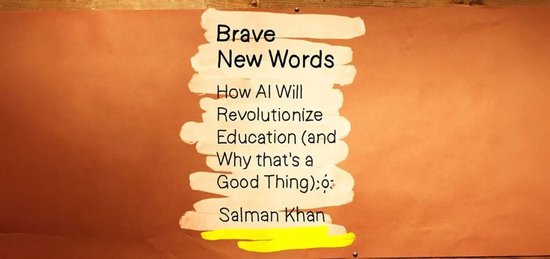炒股就看金麒麟分析师研报,权威,专业,及时,全面,助您挖掘潜力主题机会!
来源:比尔盖茨

当GPT-4o上周发布时,整个互联网(乃至全世界)的人们都为之震惊。之前与AI对话总感觉有些不真实,但OpenAI的最新模型会让你觉得是在与真人对话。你可以真正与它交谈,它也会毫无延迟地回应你。它是迄今为止我们见过的最逼真的AI,其应用场景是无限的。我首先想到的就是它将给课堂带来多大的改变,想象一下,每个学生都会有一个由这项技术驱动的个人辅导员。
我最近读了一本关于这个话题的好书——《勇敢新语(Brave New Words)》。这本书的作者是我的朋友(同时也是播客嘉宾)萨尔·可汗(Sal Khan),一位教育创新的先驱。早在2006年,萨尔就创办了可汗学院,旨在将他为家人制作的辅导内容分享给更广泛的受众。从那时起,他的在线教育平台已经帮助了全球超过1.5亿人,也包括我和我的孩子们。
早在最近的AI热潮之前,我就认为他是一位有远见的人。当得知他在写这本书时,我就迫不及待地想要阅读。如我所料,《勇敢新语》是一部大师级作品。
萨尔逐章向读者介绍了他对AI在教育领域诸多应用的预测——有些在本书成书后已经实现。他的主要论点是:AI将从根本上改善学生的学习成果和教师的教学体验,并帮助开创一个人人都能接受世界一流教育的未来。
你可能会持怀疑态度,尤其是如果你和我一样,已经关注教育技术(EdTech)运动有一段时间了。几十年来,各种令人兴奋的技术和创新频频登上新闻头条,也常伴随着类似的大胆承诺,宣称要彻底改变我们所知道的学习和教学方式——结果却只在课堂上产生了一些边缘化的影响。
但借鉴他打造Khanmigo(一个由AI驱动的辅导员)的经验,萨尔提出了一个令人信服的论点,即AI驱动的技术将会有所不同。这是因为我们终于有了一种方法,可以为每个学生提供那种之前大多数课堂和孩子都无法获得的个性化学习、支持和指导。正如萨尔所说,“为每个学生配备一个专属的、随叫随到的人类辅导员,成本太高了。”而AI辅导员则不然。
想象一下:你是一名七年级学生,数学成绩跟不上。但现在,你身边有了一个像萨尔描述的AI辅导员。当你在做一组具有挑战的分数计算题时,它不会直接给你答案,而是将每个问题分解成可理解的步骤。当你困在难点时,它会给你提供易于理解的解释,并在正确的方向上轻轻推你一下。当你最终解出答案时,它会生成有针对性的练习题,帮助你建立理解和信心。
在AI辅导员的帮助下,历史知识可以变得栩栩如生。当你学习亚伯拉罕·林肯(Abraham Lincoln)在内战期间的领导力时,你甚至可以与第16任总统本人进行“对话”。(正如萨尔在书中展示的,与我最喜欢的文学人物之一杰伊·盖茨比(Jay Gatsby)对话也是一种选择。)
当需要写论文时,不必担心那令人畏惧的空白页。相反,你的AI辅导员会通过启发思路的提问,帮助你进行头脑风暴。你会在几秒钟内得到针对你论文提纲的反馈,包括完善逻辑的建议或需要更多研究的地方。在你撰写初稿时,AI导师会实时评估你的写作(没有这种技术就做不到这点),并指出你可以阐明观点、提供更多论据或进行一些辩述。在你提交之前,它会给出详细的建议,以改进你的用语并突出你的论点。
这算是作弊吗?
这是一个复杂的问题,且并没有一刀切的答案。萨尔指出,与朋友讨论想法、请家人对作品进行点评、使用像Grammarly这样的拼写检查器和工具(可以改写整个句子)在今天的大多数标准下都不被视为作弊。同样,如果使用得当,AI不是为学生工作,而是与他们合作,推动那些可能会让他们陷入困境的事情向前发展。根据萨尔的说法,这就是为什么很多最初禁止在课堂上使用AI的教育工作者现在都鼓励学生使用它。
毕竟几年后,掌握AI可不仅仅是锦上添花——对于许多职业来说,这将是必要的。能够高效使用AI的员工将比那些不会使用AI的员工更有价值。通过将这项技术融入教育,我们不仅会改善学生的学习体验和成果,还在为他们未来的工作做准备——这些工作随着AI的加入将变得更加愉快和充实。
这也包括教学。每次出现变革性的创新时,都会有对机器抢走人类工作的担忧出现。但在教育方面,我同意萨尔的观点:AI工具和辅导员永远不能,也不应该取代教师。AI应该做的是支持和赋能教师。
迄今为止,大多数教育技术解决方案或许都很优秀,却都没有显著减轻教师的负担。但有了AI,他们就可以拥有一个超人般的助教,来处理备课和打分等日常工作——这些工作几乎会占据一个普通教师半天的时间。只需几秒钟,AI助教就能批改完拼写测试,或创建一个将工业革命与时事联系起来的课程计划。它甚至可以监控每个学生的学习进度,并向教师提供即时反馈,从而开创个性化学习的新时代。
有了AI助手处理琐碎事务,教师就可以专注于他们最擅长的工作:激励学生、建立关系,并确保每个学生都能感到自己被看见和支持,尤其是那些需要额外帮助的孩子。
当然,将AI大规模引入学校也面临许多挑战,萨尔对此也直言不讳。我们需要能保护学生隐私和减少偏见的系统。要让每个孩子都能获得使用AI所需的设备和网络连接,还有很多工作要做。没有哪种技术是教育的灵丹妙药。但我相信,AI可以在课堂、职场及其它领域改变游戏规则,发挥巨大的平等作用。
我最近参观了新泽西州纽瓦克的第一大道学校,那里正在试点使用Khanmigo。虽然还处于初期阶段,但我仍惊叹于能够亲眼目睹AI如何应用于课堂教学,并与已经从中获益的学生和老师交流。这种感觉就像窥见了未来。没有人比萨尔·可汗更了解未来教育的发展方向,因此我强烈推荐这本《勇敢新语》。
When GPT-4o launched last week, people across the internet (and the world) were blown away. Talking to AI has always felt a bit surreal—but OpenAI’s latest model feels like talking to a real person. You can actually speak to it, and have it talk back to you, without lags. It’s as lifelike as any AI we’ve seen so far, and the use cases are limitless. One of the first that came to my mind was how big a game-changer it will be in the classroom. Imagine every student having a personal tutor powered by this technology.
I recently read a terrific book on this topic called Brave New Words. It’s written by my friend (and podcast guest) Sal Khan, a longtime pioneer of innovation in education. Back in 2006, Sal founded Khan Academy to share the tutoring content he’d created for younger family members with a wider audience. Since then, his online educational platform has helped teach over 150 million people worldwide—including me and my kids.
Well before this recent AI boom, I considered him a visionary. When I learned he was writing this book, I couldn’t wait to read it. Like I expected, Brave New Words is a masterclass.
Chapter by chapter, Sal takes readers through his predictions—some have already come true since the book was written—for AI’s many applications in education. His main argument: AI will radically improve both student outcomes and teacher experiences, and help usher in a future where everyone has access to a world-class education.
You might be skeptical, especially if you—like me—have been following the EdTech movement for a while. For decades, exciting technologies and innovations have made headlines, accompanied by similarly bold promises to revolutionize learning and teaching as we know it—only to make a marginal impact in the classroom.
But drawing on his experience creating Khanmigo, an AI-powered tutor, Sal makes a compelling case that AI-powered technologies will be different. That’s because we finally have a way to give every student the kind of personalized learning, support, and guidance that’s historically been out of reach for most kids in most classrooms. As Sal puts it, “Getting every student a dedicated on-call human tutor is cost prohibitive.” AI tutors, on the other hand, aren’t.
Picture this: You‘re a seventh-grade student who struggles to keep up in math. But now, you have an AI tutor like the one Sal describes by your side. As you work through a challenging set of fraction problems, it won’t just give you the answer—it breaks each problem down into digestible steps. When you get stuck, it gives you easy-to-understand explanations and a gentle nudge in the right direction. When you finally get the answer, it generates targeted practice questions that help build your understanding and confidence.
And with the help of an AI tutor, the past comes to life in remarkable ways. While learning about Abraham Lincoln’s leadership during the Civil War, you can have a “conversation” with the 16th president himself. (As Sal demonstrates in the book, conversations with one of my favorite literary figures, Jay Gatsby, are also an option.)
When the time comes to write your essay, don’t worry about the dreaded blank page. Instead, your AI tutor asks you thought-starters to help brainstorm. You get feedback on your outline in seconds, with tips to improve the logic or areas where you need more research. As you draft, the tutor evaluates your writing in real-time—almost impossible without this technology—and shows where you might clarify your ideas, provide more evidence, or address a counterargument. Before you submit, it gives detailed suggestions to refine your language and sharpen your points.
Is this cheating?
It’s a complicated question, and there’s no one-size-fits-all answer. Sal notes that bouncing ideas off friends, asking family members to critique work, and using spellcheckers and tools like Grammarly—which can rephrase entire sentences—aren’t considered cheating today by most measures. Similarly, when used right, AI doesn’t work for students but with them to move something forward that they might otherwise get stuck on. That’s why, according to Sal, a lot of educators who first banned AI from class are now encouraging students to use it.
After all, mastery of AI won’t just be nice to have in a few years—for many professions, it’ll be necessary. Employees who can use AI effectively will be far more valuable than those who can’t. By incorporating this technology into education, we‘re both improving students’ experiences and outcomes and preparing them for the jobs of the future—which will become more enjoyable and fulfilling with AI in the mix.
That includes teaching. With every transformative innovation, there are fears of machines taking jobs. But when it comes to education, I agree with Sal: AI tools and tutors never can and never should replace teachers. What AI can do, though, is support and empower them.
Until now, most EdTech solutions, as great as they may be, haven’t meaningfully made teachers’ lives easier. But with AI, they can have a superhuman teaching assistant to handle routine tasks like lesson planning and grading—which take up almost half of a typical teacher‘s day. In seconds, an AI assistant can grade spelling tests or create a lesson plan connecting the Industrial Revolution to current events. It can even monitor each student’s progress and give teachers instant feedback, allowing for a new era of personalized learning.
With AI assistants handling the mundane stuff, teachers can focus on what they do best: inspiring students, building relationships, and making sure everyone feels seen and supported—especially kids who need a little extra help.
Of course, there are challenges involved in bringing AI into schools at scale, and Sal is candid about them. We need systems that protect student privacy and mitigate biases. And there’s still a lot to do so that every kid has access to the devices and connectivity they need to use AI in the first place. No technology is a silver bullet for education. But I believe AI can be a game-changer and great equalizer in the classroom, the workforce, and beyond.
I recently visited First Avenue School in Newark, New Jersey, where Khanmigo is currently being piloted. We’re still in the early days, but it was amazing to see firsthand how AI can be used in the classroom—and to speak with students and teachers who are already reaping the benefits. It felt like catching a glimpse of the future. No one understands where education is headed better than Sal Khan, and I can‘t recommend Brave New Words enough.














